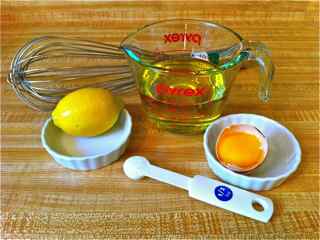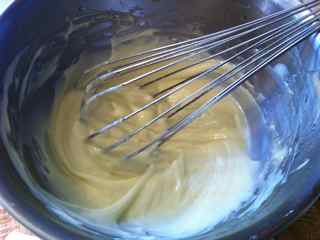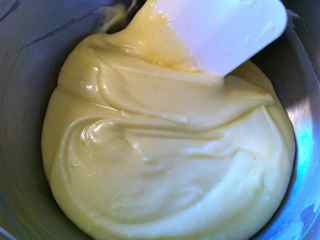Mayonnaise is a magical food. A true example of culinary alchemy- taking three disparate and separate ingredients- egg yolks, acid and oil, and mixing them to a beautiful, luxurious ‘sauce’. It can morph from a simple sandwich spread to a binder for a potato salad. Thinned out with a bit of liquid and it becomes a sauce for fish or vegetables. The addition of aromatics and herbs and it becomes even for exciting. I didn’t always have this enthusiasm for mayonnaise though. As a child, I wasn’t crazy about the mouthfeel, that rich oiliness was too much for my simple palate. However, I grew up with a jar of Best Foods Mayonnaise in our refrigerator and we used it on the usual suspects- sandwiches, potato and macaroni salads. It was an ingredient I took for granted. Even into adulthood, I bought a jar of mayonnaise automatically as part of our condiment shelf in the fridge, next to the dijon mustard and ketchup. I never thought much about it as anything more than a binder for cold salads and a spread for sandwiches and I certainly never thought about making it from scratch.
Fast forward to my late adulthood when I switched careers and became a student at California Culinary Academy. It was during my Basic Skills class when I learned that Mayonnaise with a capital ‘M’ was a very important sauce in the classical French kitchen and was one of those staples in the professional kitchen so it was in our checklist of ‘mother sauces’ to master. For several days, I made mayonnaise by hand and tasted the results throughout the process. Imagine tasting mayonnaise at 7:00 am! Not pleasant. But after a few days of sore arms after all the furious whisking of oil into the egg yolks, I felt a new appreciation for this amazing sauce. I discovered that handmade mayonnaise has a delicate almost luxurious texture and fresh taste that I never experienced with store-bought mayonnaise.
So what IS mayonnaise? It’s an amazing mix of oil and acid called an emulsion. An emulsion is when components that don’t naturally meld (like oil and water) are forced together by adding agitation and a protein; in the case of mayonnaise, the agitation is my arm working a whisk vigorously and the protein is an egg yolk. The trick with mayonnaise is to add the oil slowly at first- by drops, to allow the emulsion to form and become stable. As it becomes more stable, the oil can be added in a thin stream as you continue whisking. Now, I had always made mayonnaise by hand, partly because I’m a sadist and partly because I felt I could control the amount of oil that was whisked in to the egg yolk and vinegar mixture. I felt comfortable with mayonnaise-making until I had the unfortunate accident of breaking a mayonnaise. I was working as a line-cook and had just started my new job when I was given the task of making a very fancy and expensive mayonnaise with the $35 bottle of
Ligurian olive oil. I was asked to make it in the food processor and I set about starting the machine and adding the oil. As I dribbled the oil in slowly, I heard the happy noise of an emulsion forming (thwup, thwup, thwup). Perfect, I thought. The executive chef was a few feet away and watching me. Beaming with confidence, I added the oil faster and then disaster struck: I heard the machine make a bad noise- shplak, shplak, shplak! I had broken the emulsion! I cursed profusely in my mind, stopped the machine and hoped that the executive chef hadn’t noticed. Sadly, she DID notice and proceeded in giving me a lesson in fixing mayonnaise, something I had already known to do. I was humbled and humiliated and listened to her lecture about how emulsions worked and so forth. I fixed the mayonnaise and we carried on. Afterwards, I was relegated to lowly grunt work like peeling potatoes, grating cheese and the like because of my error. I persevered and eventually won back the chef’s confidence in my abilities, but making any kind of mayonnaise in that kitchen always set me on edge. To this day, I still feel a tinge of anxiety when making any kind of mayonnaise. Recently, I ran into Michael Ruhlman’s book Ratio and the chapter on fat-based sauces, I decided it was time to conquer my fear of homemade mayonnaise. I had much success with the other chapters in his book so I had no doubt that his mayonnaise ratio would have a favorable outcome. I discovered the secret to his fool-proof ratio was the addition of water in the initial mixture of egg yolks, acid and salt. We are taught in culinary school that 1 yolk can emulsify a cup of oil so the idea that a single yolk can really emulsify more than a cup of oil with the addition of water was astounding and liberating. I remember breaking mayonnaise because there wasn’t enough liquid with the egg yolks! I breathed a sigh of relief and whipped up a batch of his Basic mayonnaise with a touch more lemon because I like lemon. Easy peasy! Then I did a second batch called Instant Mayonnaise using an immersion blender. Holy Cow! Three minute mayonnaise. I almost cried because it was so simple! Dramatic, I know, but trust me, this is a big deal for me. So the next time you need mayonnaise, for your sandwich or as a dip for your French fries, give this recipe a whirl. You’ll be amazed at how simple and magical it is.
Basic Mayonnaise- with thanks and acknowledgement to Michael Ruhlman
1 large egg yolk, preferably organic or farm-raised, at room temperature
1/2 teaspoon salt
1 teaspoon water
2 teaspoons fresh lemon juice, or to taste
7 to 10 ounces canola oil (about 1 cup)
1. Combine the yolk, salt, water, and lemon juice in a large bowl (the bigger, the better, even for a small quantity of oil). Twist a dish towel into a ring around the base of the bowl to keep the bowl from moving as you whisk in the oil. Measure out your oil in a cup from which you can pour it in a steady stream, such as a 1-cup Pyrex measuring(a cup of oil weighs 7 ounces).
2. Begin whisking the yolk, then drizzle in a few drops of oil while whisking, followed by a few more drops of oil to establish the emulsion. Whisking continuously, add the remaining oil in a thin stream. The mixture should be thick enough to cling to your whisk. If you can pour it, the mixture has broken. If this happens, pour the broken mayonnaise back into the oil cup, wipe out your bowl, and add a teaspoon of water to the bowl (add a little extra yolk if you have it). Pour the broken mayonnaise drop by drop into the teaspoon of water while whisking rapidly to establish the emulsion, then continue to add the broken mayonnaise in a thin stream.
Variations to add to the Basic Mayonnaise- lemon juice, shallots, lime juice, minced garlic, chopped herbs, powdered spices, chopped pickles.
Note: This mayonnaise can be made with the immersion blender by simple mixing the yolk, salt, acid and water in a glass jar or pyrex measuring cup. Buzz it once to mix, add a few drops of oil and blend again. With the blade running, pour the remaining oil slowly in the cup while lifting the immersion blender up and down to incorporate the oil. Once you start blending, the process should take 15 to 20 seconds. Presto! Instant Mayo.











Leave a reply